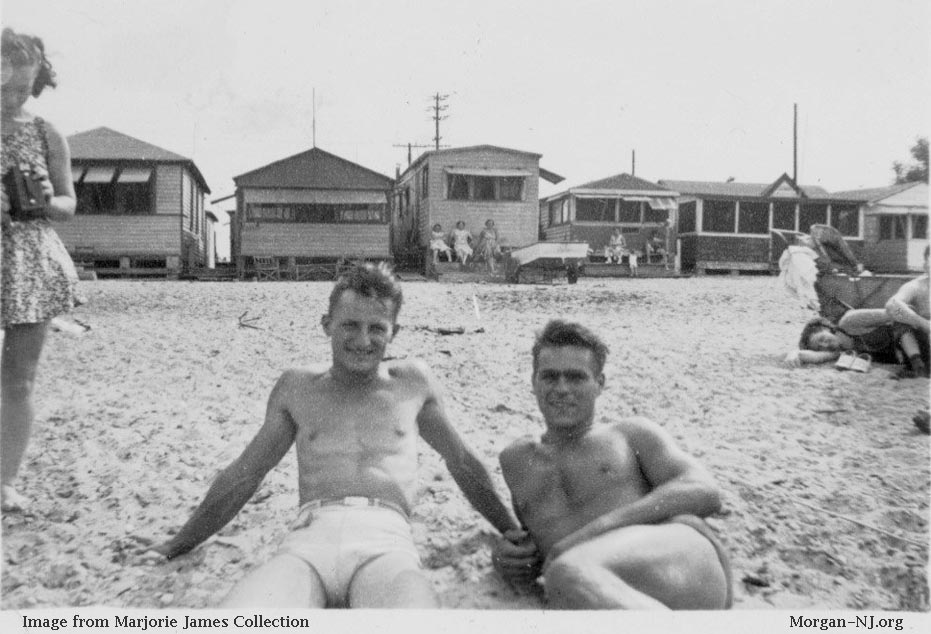
Bette Adams, Edward Thalmann and “Strip” on Morgan Beach circa 1938. Image courtesy of Marjorie James.
Morgan Memories – Morgan Beach Days
From the time I was in diapers, my family would very often and very fondly speak about times surrounding “the bungalow on Morgan Beach.” There was such joy in their hearts on this topic and smiles on their faces.
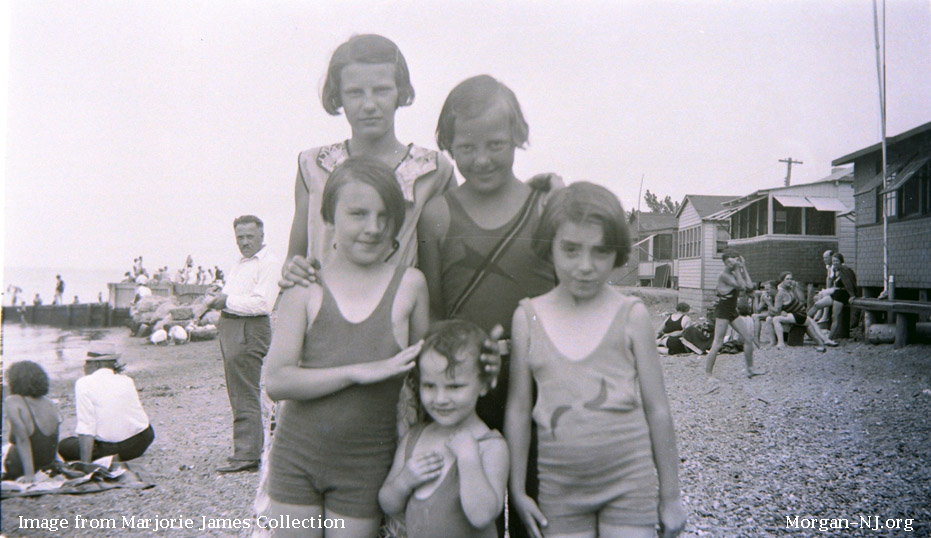
Dorothy Thalmann, Marjorie Thalmann, Audrey Green and Two Unknown Young Girls on Morgan Beach circa 1930. Image courtesy of Marjorie James.
My mother went to the family bungalow every summer with her brother and parents from when she was a little girl in the late 1920’s until whenever the day was when it all ended. Sadly, by the time I came around, Morgan Beach was a somewhat featureless stretch of dirty sand, often with washed-up trash, fronting a bay of cloudy green polluted waters. While the beach is still there, the structures are long gone.
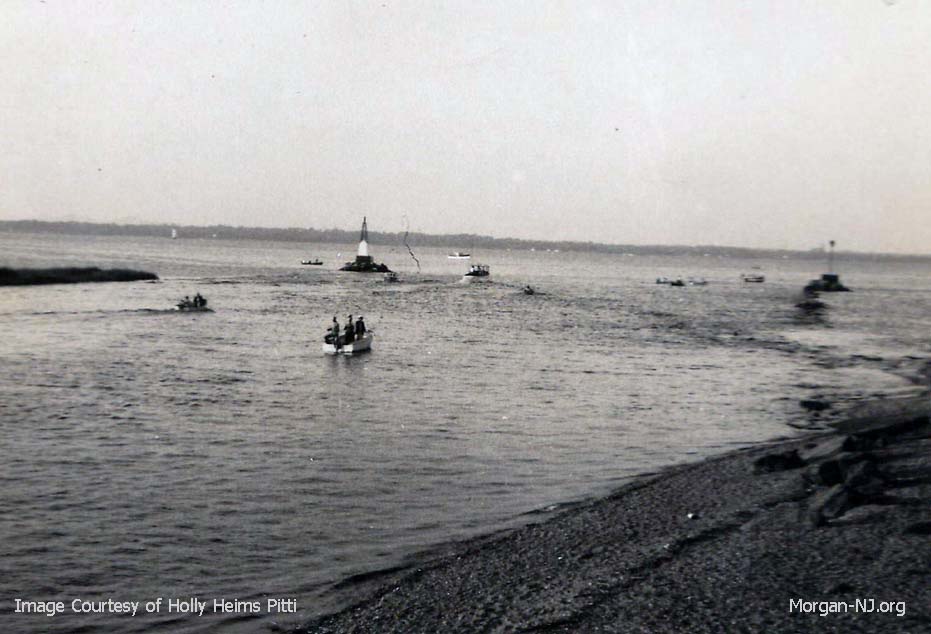
Looking from Morgan Beach to the end of Cheesequake Creek Channel into Raritan Bay circa mid-1950s. Image courtesy of Holly Heims Pitti.
On the northwest side of Morgan Beach is a boat channel nestled between two long rows of giant rocks known as the jetties. In “back,” along the southwest side, is a trestle roadway leading up to the NJ State Highway Route 35 drawbridge. Running parallel on the bay side to this “new” bridge is a strange vestigial stretch of concrete which abruptly ends at the channel. This is the remains of the earlier roadway to the two earlier bridges over Cheesequake Creek. On the southeast side, opposite the channel, are the hills of Laurence Harbor – now a neighborhood but in earlier times a golf resort. Also hidden away at the top of the hill is the ancient Bowne-Provost Family Cemetery which dates back to 1684. Finally, on the last side – the northeast side – is Raritan Bay. The locals didn’t consider the stretch of shoreline north of Cheesequake Creek, which parallels the railroad tracks toward South Amboy, as “Morgan Beach” though I guess technically one could and probably one should. But we didn’t.
While growing up, the physical Morgan Beach sure didn’t seem special to me in any way. When the weather got hot, my sister, brother and I were brought to the beach and into the water we would go. You would hear that the bay was polluted and to be careful about walking barefoot on it. Indeed when she was very young, my sister Linda stepped on the remains of a broken light bulb on the beach thus warranting some serious stitching up. In the water, there were stinging jellyfish which would leave a painful big red welt on your skin if you encountered them. How about the huge green-headed flies? Nasty! During the late spring to the early summer, strange upside-down bowl-shaped creatures – actually shaped like a horseshoe – with many legs and a long terrifying looking spike sticking up or sideways would crawl up onto the beach; hence their name, “Horseshoe Crab.” Often times you would find them upside down either with their crawly legs rhythmically moving back and forth or totally immobile. They seemed to be dead (they often weren’t dead, however, just stuck in an awkward and usually, for them, a deadly position).
No, by the time I came into the movie, Morgan Beach was not even a shadow of its former self. It was just an abandoned stretch of happy memories.
This writing, and the related writings from Betty Litowsky about Morgan Beach and her growing up at the Robert E. Lee Inn, will attempt to document what I know and have learned to date about this geographic location which, I would realize quite late in life, played the most significant role in the lives of my sister, brother, and me. Strangely, despite researching for a now large number of years about the beach colony which was the essence of what was cherished about Morgan Beach Days, I have still not yet found all of the authoritative answers to its start or its ultimate demise.
We do however get a little insight into beach goings on in the mid to late 1800s from a 1916 lawsuit between Plaintiff Archibald A. Rowan and Defendant William A. Mundy regarding who actually owned the beach property. This site often references back issues of the “South Amboy Citizen Newspaper” and we are very grateful to the citizens of South Amboy who, through their Sadie Pope Dowdell Public Library, provide everyone anywhere in the world free access to their archive. Here is the text for two articles which we are interested in for this case. Later, we’ll show a link to go to another page full of other Morgan Beach related articles in the Citizen from the early 20th Century.
South Amboy Citizen – January 22, 1916
ROWAN WINS TITLE TO LAND
Jury in Ejectment Suit of Archibald H. Rowan vs. William A. Mundy for Possession of lands at Morgan Beach Decides in Favor of Plaintiff–Will Seriously Affect the Bungalow Colony.
The long deferred suit of Archibald H. Rowan against William A. Mundy in ejectment for possession of land at Morgan Beach occupied the time of Judge Lloyd in the Supreme Court in New Brunswick on Tuesday and Wednesday. It was before a jury which returned a verdict for the plaintiff [Rowan].
Mundy claimed title under adverse possession of twenty years, and of having purchased title from the estate of Abraham Applegate, who used it as a fishing ground previous to his death.
Rowan claimed the land under “paper title” which is backed up by a number of old deeds. The first record produced was that of a deed given by John Travers and Harriet, his wife, to William Ross, in 1855, taking in a large tract of land including the beach front. Ross later transferred the property to the father of the present plaintiff [Rowan].
The original tract was split up into a number of smaller lots, and the present suit involves only the strip of beach now used by the campers. The land is at the Junction of Cheesequake Creek and Raritan Bay, and runs to Laurence Harbor.
Mundy claimed that he purchased the land from the estate of Abraham Applegate in 1904, receiving a deed from Frederic M. P. Pearse, the executor of Applegate’s estate. He declared that Applegate had been in possession of the land ever since 1866 and his possession had never been disputed or disturbed in any way, so that he has a clear title under the Statute of Limitations.
This was the only defense made to the suit. Mundy admitted that the Rowan family got title to a part of the original tract, but that they were never in possession of the beach and that Ross was never there. He also claims that the sale of the beach to him by the Applegate estate was publicly advertised and the land was auctioned off, but that Rowan never made any objection, although he knew all about the sale. He also claimed that the present plaintiff [Rowan] never acted in the matter except as the agent of his father.
The jury selected was as follows: Joseph H. Petty, A. H. Bram, James E. Nolan, Leonard Wehrfritz, George Erath, Albert Clark, Paul Rush, Clarence Perrine, Stephen Conover, William H. Lake, William Messmahi and Henry J. Osterling.
The testimony of a number of old residents of Madison Township was taken, who testified that Abraham Applegate, the defendant’s grantor, had been in possession of the property for more than twenty years.
The rebuttal of this claim was then taken up by the plaintiff, who called witnesses to testify that this possession, which was admitted, was with the consent of D. Noble Rowan, Applegate having leased the property and that he therefore did not acquire any title through adverse possession.
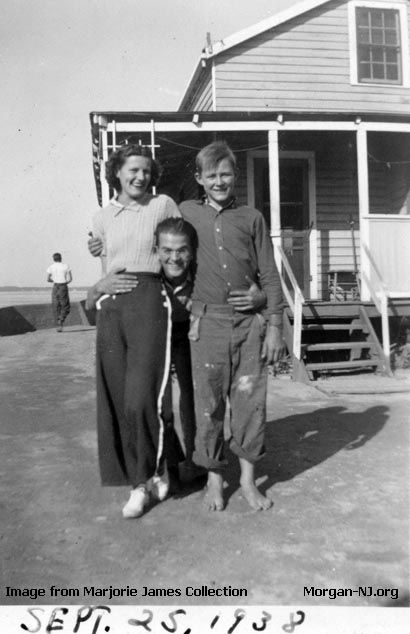
Dorothy Thalmann, Jimmey Thetford, and Billy Vroome in front of “Hock’s Pavilion” on Morgan Beach on September 25, 1938. Image Courtesy of Marjorie James.
William Mabley, a grandson of Applegate, testified that he worked for his grandfather on the beach from 1881 to 1886, and that at that time Applegate had a number of windlasses on the beach for hauling in his seines [fishing nets which hang vertically in the water] and that he also had two or three small buildings used for storing his nets. About 1884, according to the witness, Applegate built a shanty for his men to live in during the summer. This testimony was corroborated by Andrew H. Slover, who used to sell groceries to Applegate at the beach, John Woods and William McDowell.
Slover stated on cross-examination, however, that Applegate voted from the village of South Amboy and not from the beach and that be lived in South Amboy most of the time. Mabley admitted that the windlasses on the beach were all movable, and were often shifted from place to place.
Applegate’s will, a decree of the Court of Chancery authorizing his executor to sell the property, and a deed from Frederic M. P. Pearse as executor to William A. Mundy, the present defendant, were then produced to show Mundy’s acquisition of Applegate’s title. The defendant rested his case here, and the plaintiff attempted to prove that Applegate held the property under a lease from D. Noble Rowan.
This claim was aided considerably by one of the defendant’s own witnesses that at the time the property was sold for taxes in 1902. Mr. Rowan asked Mr. Applegate for the back rent on the property but Applegate refused to pay it.
Edward Barker, the Township Collector, who is 60 years old, testified that he remembered going down to the beach as a boy to fish and that Applegate was then in possession. He also had a house on the property in which his workmen lived during the fishing season, and the witness testified that it was “a regular boarding house.” Baker testified that the houses on the beach were built by Applegate.
On cross-examination, however, the witness admitted that for a long time Applegate boarded his men at a place on the other side of Cheesequake Creek and not on the property in question. He also admitted that Applegate lived chiefly at South Amboy and not on the property. Barker’s testimony was largely corroborated by Frederic Schoonmaster, the Town Clerk.
Rowan Bid at Tax Sale.
Evidence which the defendant claimed showed that Rowan had no title to the land was then given by Ebenezer Bound, former Collector, who testified that in 1902 the property was sold for taxes and that Applegate and Rowan bid against each other for it.
This evidence started an interesting legal battle when former Justice Collins, counsel for the plaintiff, objected to the evidence. It was admitted, however, as tending to show whether or not Rowan thought he had title to the land. During the fight, Judge Collins won a point by reading into the record a lengthy extract from a previous trial of the case which tended to impeach the testimony of the witness. His persistence in reading the extract despite objections ‘by opposing counsel and the court and his repeated declarations that there was “only a little bit more” created considerable amusement in the court room.
An interesting legal point was brought up during the afternoon when the plaintiff objected to the sufficiency of the defendant’s pleadings by claiming that the defendant could not receive any benefit from Applegate’s adverse possession unless the full term of twenty years had been completed before the transfer of the property. A ruling on the point was made unnecessary, however, by the amendment of his pleadings by the defendant so that it was claimed that Applegate had finished the term.
Neilson B. Gaskill and Frederic M. P. Pearse represented the defendant, and former Supreme Court Justice Collins and C. I. Voorhees appeared for the plaintiff.
As many people have built shacks on the beach and taken lease from Mundy they stand in a peculiar position. Should they be compelled to move it will place them in a sorry plight, as they have spent hundreds of dollars in buildings which will be costly to transfer to other parts.
The April 1, 1916 issue has an article regarding one of the outcomes of the case’s decision.
MUNDY MUST VACATE LAND
Sheriff Houghton on Monday Served Dispossess Notice to Occupants of Land at Morgan Beach to Move Off in Thirty-Three Days – Wm. Rea Placed in Charge of Rowan’s Interest.
On Monday last Sheriff Edward F. Houghton and Archibald Rowan went to Morgan Beach and served dispossess notice upon William A Mundy to vacate the property within thirty-three days. This is the outcome of a suit for ejectment started in the Supreme Court some months ago, in which Rowan won out. Mundy applied for a writ of appeal which was not granted by the court.
From recent action in the Supreme Court it was decided that Archibald Rowan and Morris Brothers of Philadelphia held title to this tract of land running from Cheesequake creek along the bay front to lands of Lawrence Lamb. Mundy came into possession of the property by purchasing the right, title and interest of the late Abraham Applegate at executor’s sale, which they supposed gave them title. Action in the Supreme Court showed that Applegate held no interest in this land.
Many bungalows have been built on this property through leases from Mundy & Hunt. The owners are now wondering how they will be affected by the new state of affairs, and are in hopes they will be allowed to remain in the enjoyment of their summer homes. The Rowan tract runs from the jetties along the shore front a distance of 1,070 feet. Mr. Rowan has placed William Rea in full charge of his interests. Mr. Rea resides at the beach and ran be found at any time by those seeking Information.
Origin Story
It seems likely there were four significant milestones leading to the series of events leading to the creation of the Morgan Beach colony. The first was the building of a toll “draw or swing bridge over and across Cheesequake Creek, at or near its mouth” sometime during or soon after 1858 along with what became a county road over it – essentially present-day NJ State Highway Route 35. Prior to the building of this bridge, it isn’t clear how people would have crossed Cheesequake Creek should they have been in the area. Likely there might have been some row boats at what was likely called “The Applegate Hotel” (later to be called “Ye Old Spye Inn”) or perhaps, as some say, via a horse-drawn buggy at low tide.
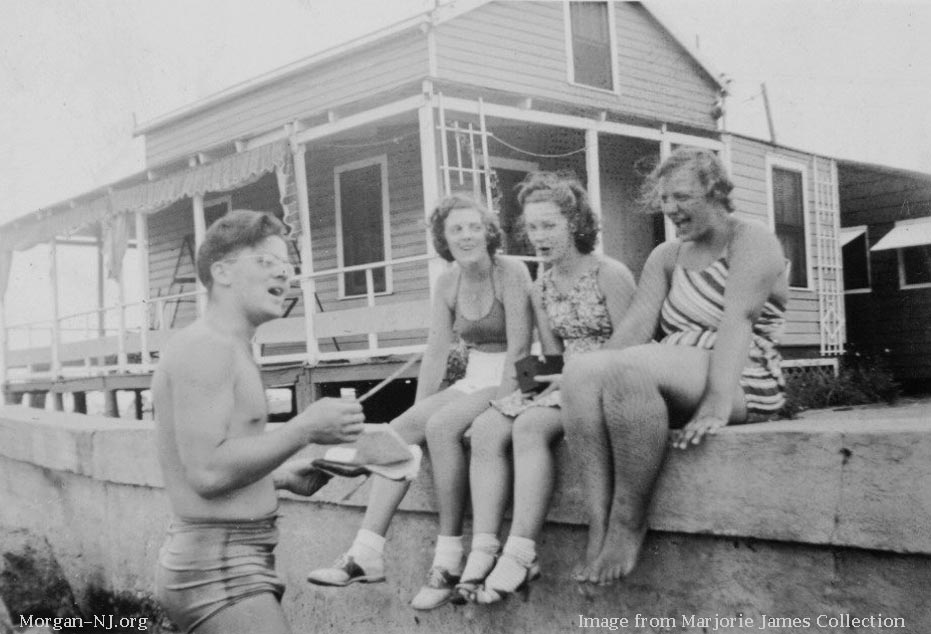
Jimmey Thetford, Rita Casey, Betty Adams, and Marjorie Thalmann on Morgan Beach circa 1938. Image courtesy of Marjorie James.
The second most significant, and likely the most significant early milestone allowing for easy access to the beach, would have been the laying of the New York and Long Branch Railroad (NYLB RR) which incorporated the coastline of the Morgan family’s property between Cheesequake Creek and South Amboy. A small station was placed at the point on the Morgan property where the railroad crossed the creek, as verbal history recalls, at the insistence of owner James Rutus Morgan. The NYLB RR opened in the summer of 1875 allowing for a trip to New York City in about an hour and ten minutes! This must have been just a miracle to James Rutus Morgan who, like his ancestors, would have previously had to spend large amounts of time in transit getting to Manhattan either via horse or by boat. The NYLB RR brought people from both northern New Jersey, directly, and people from southwestern New Jersey via a transfer in South Amboy from the Camden & Amboy Railroad. Probably at that time, there were ferries as well either in South Amboy or Perth Amboy. From Morgan Station, it would then have been a walk of just few hundred feet over the county road bridge to arrive at the sands of Morgan Beach. For those living in the northern part of New Jersey, Morgan Beach was essentially the first stop on the trail of the still fabled “Jersey Shore.”
The third milestone was likely the auctioning off of the majority of the Morgan Family estate sometime in the summer of 1893. This opened up development of housing in “Morgan Heights,” the area on the north side of Cheesequake Creek at the top of the bluff. More on this, hopefully, in a future Morgan-NJ.org page though it does not look as if property on what is known as Morgan Beach was part of that massive estate sale.
The fourth milestone would have been the Jersey Central Traction trolley company which opened in Morgan, with a stop at Morgan Beach, in 1905.
With the country road/bridge, railroad, land availability, and later, the trolley going right through Morgan Beach, it would have been a natural thing for people to start building “bungalows at the shore” there.
The earliest image identified to date thus far is from Frank Leslie’s Illustrated Newspaper from September 2, 1876. This image can be seen on page 103 of the book “Images of America Sayreville” by the Sayreville Historical Society.
The image’s caption reads, “This sketch depicts Morgan beach overlooking Raritan Bay. Here, the West Side Relief Association ran a summer mission for disadvantaged women and children from New York City’s West Side tenements. The association paid $1 to send a child for a week’s stay at the seaside sanitarium; the expense for a woman was $3.” This was the summer the year following the opening of the railroad. No time was lost there!
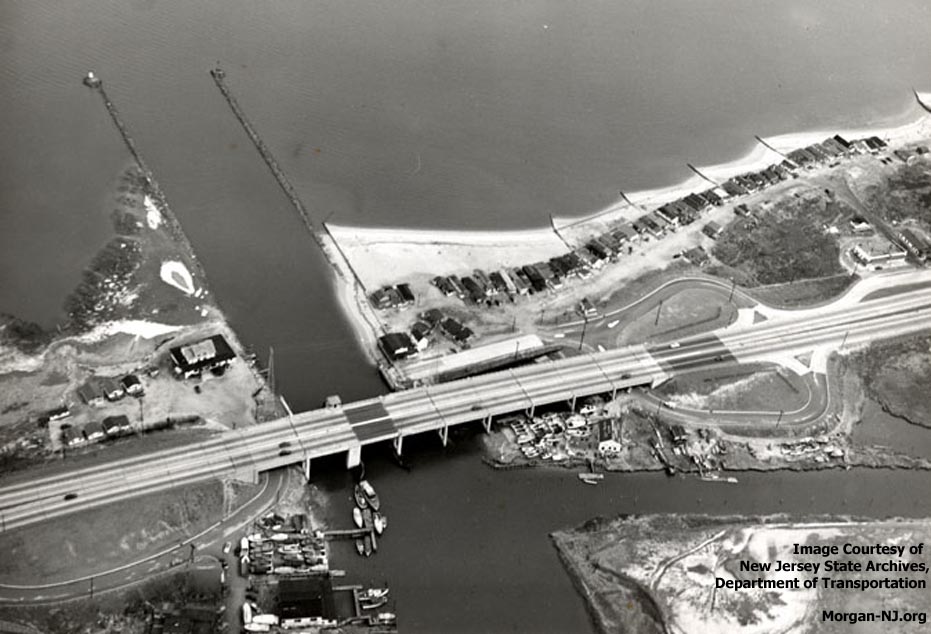
Aerial View of Morgan Beach and Robert E Lee Inn sometime after 1946. Image courtesy of the New Jersey State Archives, Department of Transportation.
http://www.nj.gov/state/archives/images/str00001/BridgeCheesequake001.jpg
The first half of the 20th Century seems to have been the heyday of Morgan Beach. Food – fish, clams, crabs, oysters, etc. – was plentiful and easily obtained from the creek and bay. Local businesses and the actual beach attracted outside visitors. Morgan was an area of great change, growth, and commerce. You can read about the “Morgan Dance Hall” here.
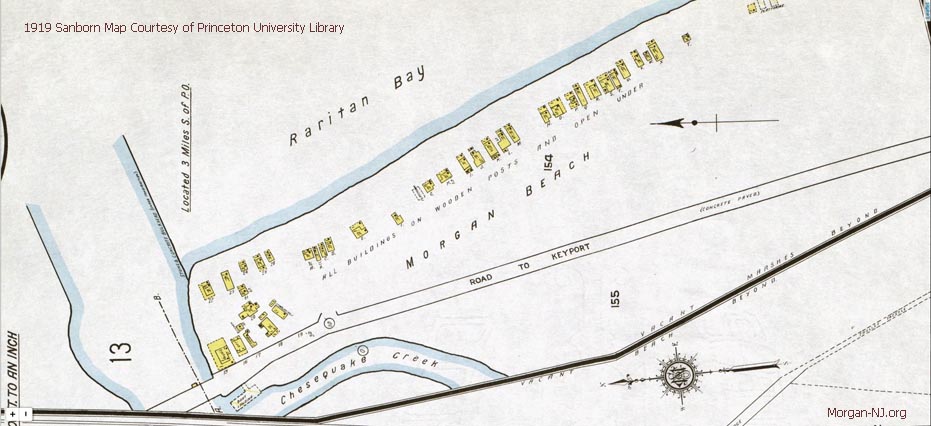
1919 Sanborn Fire Map of Morgan Beach. Image courtesy of Princeton University Library.
https://catalog.princeton.edu/catalog/5537445#view
Sometime either in the 1920s or certainly by the 1930s, my grandparents acquired one of the bungalows on Morgan Beach. My grandfather might have actually built it – he was amazing like that. Per Cousin Stacey, this specific bungalow, #15, was of a type of architecture known as “Shotgun.” A Google search on that term reveals it to be a narrow house where the rooms are aligned one after the other with doors on both of the short ends of the rectangle. The phrase “shotgun” appears to stem from the notion that a projectile could be shot from the front door through the back door without hitting the interior walls. While some families only lived “at the shore” seasonally, there were a number of families who lived there year round. Stacey’s family had a period where they lived there while their house on Midland Avenue was being built (by her father and grandfather – both were amazing like that).
Family lore has it that the bungalow, probably like most of the others on the beach, originally had no running water or electricity. Indeed, I have a kerosene “Hurricane Lamp” my family used in it. Despite hearing about Morgan Beach and the bungalow all my life, I never actually saw what the beach or the bungalow looked like until we moved my Mother out of her Morgan house many years after I moved out of New Jersey. Buried in one of the only boxes I had not sifted through during the long painful New Jersey childhood winters was a stockpile of photos of friends and family on the beach primarily during the time period of the 1930s. Many of the photos from this box of photos are squeezed into this page.
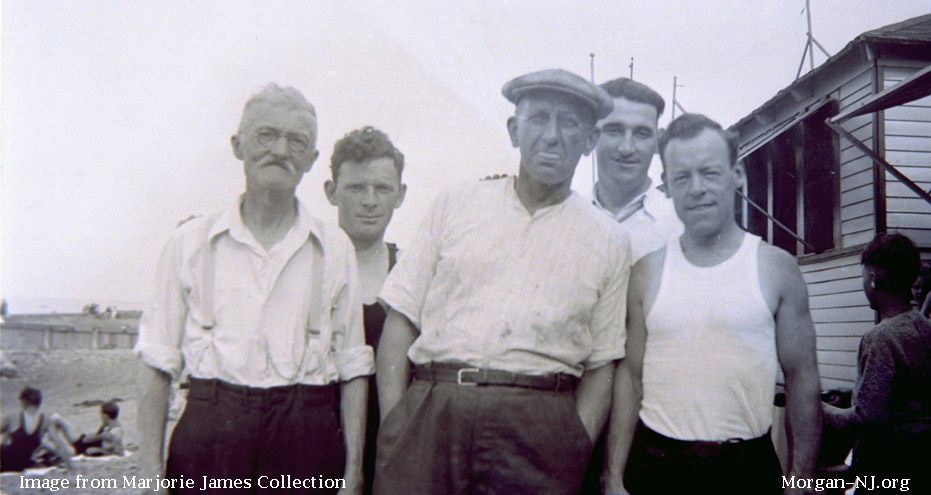
Gottleib Thalmann, Unknown, Daniel McHugh, Jim Green & Walter P. on Morgan Beach. Year Unknown. Image courtesy of Marjorie James.
Stories
My mom shared that both of her grandfathers used to catch bait and sell it to the Lockwood family who owned a bait shop on Cheesequake Creek at the time. The Lockwood family would later found the Lockwood Boat Works which celebrated its 70th anniversary in 2016.
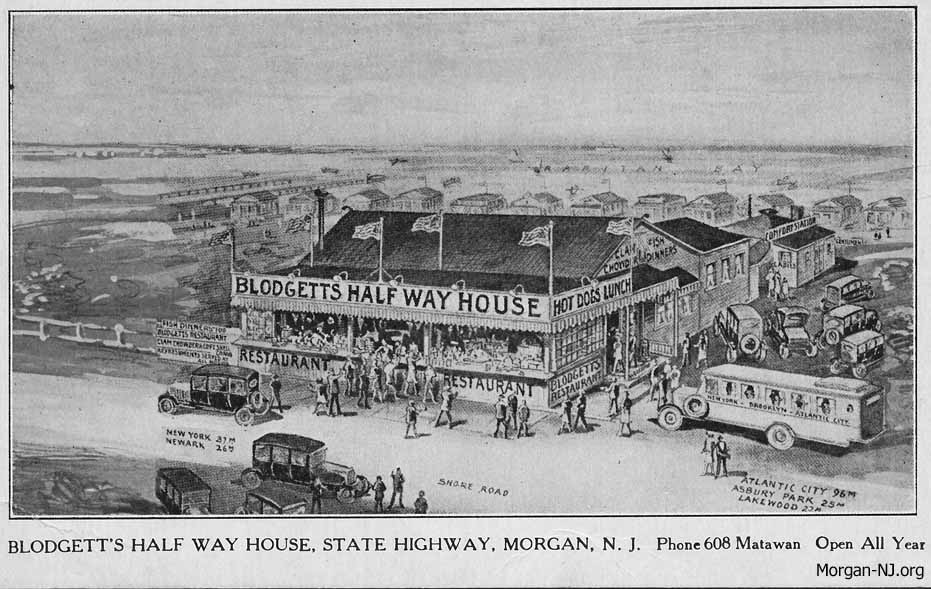
Landis & Alsop Picture Post Card of Blodgett’s Half Way House on Morgan Beach. Year Unknown but possibly 1920’s.
Mrs. Walker’s Carnival
Both my mother and Betty Macrae Litowsky talked about a lady named Mrs. Walker. Per Betty, Mrs. Walker was the daughter of Colonel Walker who was the “Walker” half of “Morresey and Walker,” the renowned builders of many of the small towns in Middlesex County (namely Laurence Harbor and Cliffwood Beach).
My mother told a story about Mrs. Walker. Mrs. Walker was a carnival person. One day, when my mom was a very young girl (circa 1930), Mrs. Walker asked my mom if she and two of the other girls from the beach (Betty Stenhouse and Gladas Gilhoauser) would like to have a carnival? Yes! The girls excitedly sold tickets for 5 cents apiece. They went to all their Morgan Beach neighbors and also walked up to Lawrence Harbor to sell them there.
On the day, there was a large turnout of people who came to see the carnival. Mom, dressed as a Hula girl, was at the entrance and collected the tickets. Among the featured acts were: Mrs. Walker’s two monkeys (kept in a cage) – one of the monkeys was named “Nancy”, a big turtle from out in the water found by Bill Gilhoauser’s son, his sister, who was very heavy, volunteered to play the “Fat Lady”, and Mom’s Uncle Danny who put flies on pins that would wiggle around (sounds kind of gruesome).
Ticket sales brought in over $11 – not bad at 5 cents a ticket! The girls used the proceeds to buy Mrs. Walker a couple of house dresses that she could wear. Mrs. Walker was very appreciative of the gift!
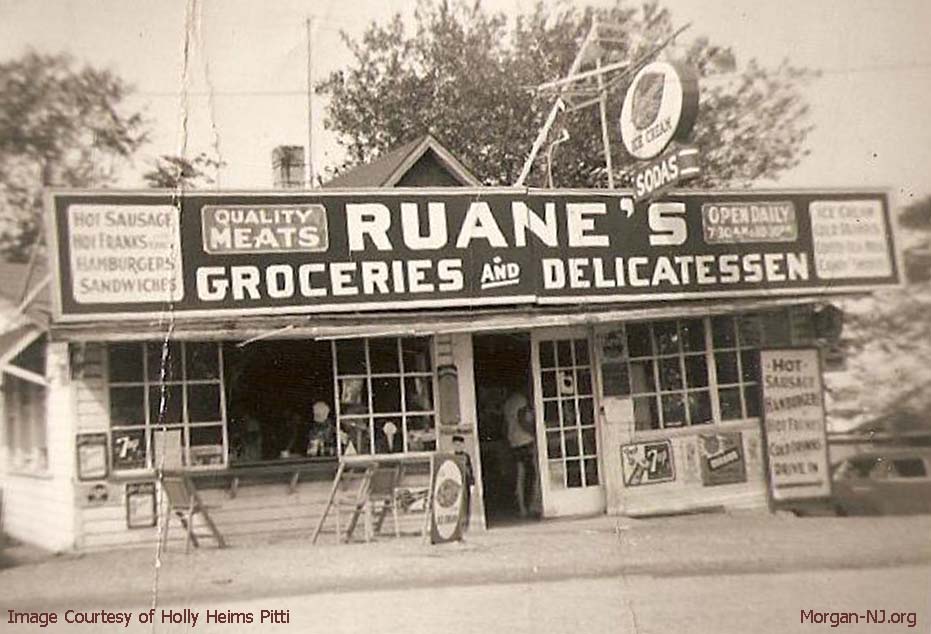
Only known image of Ruane’s Groceries and Delicatessen on Morgan Beach. Year unknown. Image courtesy of Holly Heims Pitti.
Other People’s Stories
Morgan-NJ.org reader Don Hannon, contacted me and shared a little of his story.
I really don’t have any specific stories to tell you. I was just a poor kid that lived on the beach year round starting from 1942. I spent the first 11 years of my life on Morgan Beach and am hoping to make contact with someone else who was there.
We watched the summer people come in and leave in the fall. I had the run of the beach as a kid. If you could swim across the creek and back at high tide then your parents left you alone knowing that you could handle anything the water had to offer. Jumping off the bridge or cannonballing any boats that came by was just a part of your day.
I hung around my great aunt’s grocery store a great deal of the time and lived in the back of the store for a while. She was Kathern Ruane and the store was Ruane’s grocery store [Editor’s note, this appears to be the same building Betty Litowsky names as “Demicelli’s” in her stories. Probably the owners changed hands at some point.]
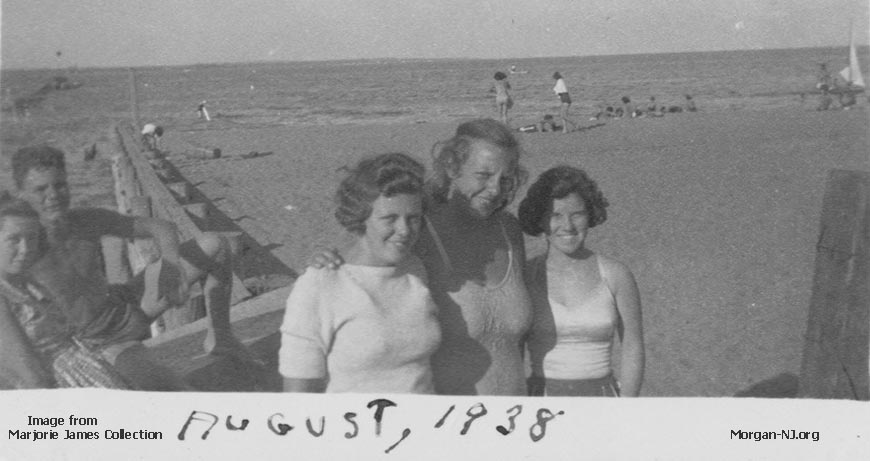
Modesta Casey, Marjorie Thalmann, Mildred Macolino near the retaining wall on Morgan Beach. The Lollipop can be seen at the end of the jetty at the top left. Image courtesy of Marjorie James.
Kaisers was next store and I used to shine shoes for pocket change that I used to buy the best french fries in the world from Fritz the cook. I pretty much had no one to answer to and never got in any bad trouble. In the winter we use to sled down the hill by the bridge but that was about the extent of my memories on Morgan Beach. I did get my picture in the New York Daily News centerfold for saving a duck that was caught in an oil slick on the bay. Had the picture, gave it to my son who promptly lost it and we have been unable to find out how to get a copy of it from the paper. That’s about the extent of my time there. We lived in Laurence Harbor for a short while as we were having a house built in Cliffwood Beach. We continued to go down in the summer in a house we rented behind my great aunt’s store until they shut the beach down.
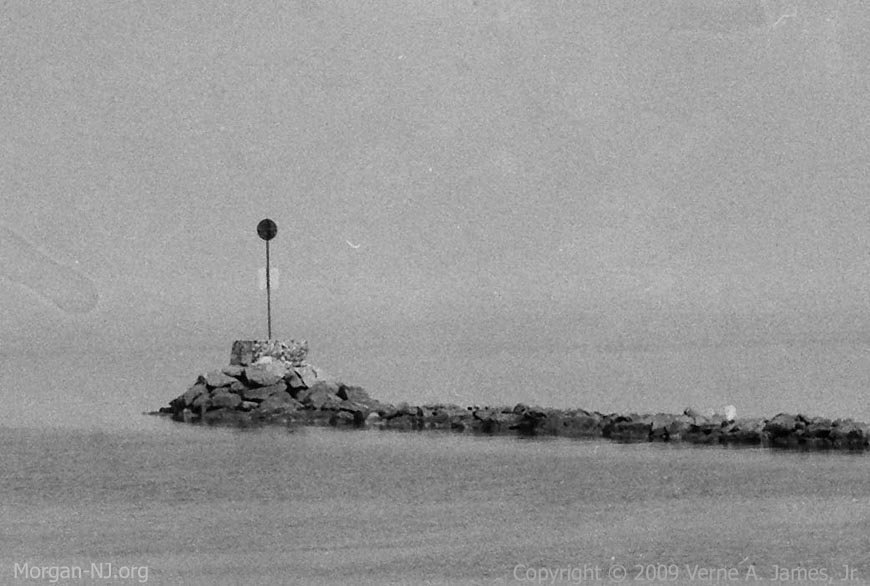
The “Lollipop” which marked the entrance to Cheesequake Creek. During very high tides when the rocks of the jetty were covered with water, the Lollipop let Mariners know where the jetty rocks were located.
The reason we were given for the beach closing is that they were going to build an amusement park on the beach but it never happened. I have been back there a couple of times, the last time I took my two grown granddaughters out to the lollypop but have not been back in several years. I know people still go down there to swim and sunbath but it’s sad to see it not being taken care of.
It was wonderful to have been able to provide Don with the above image of the store through the generosity of my school classmate Holly Heims Pitti. Don said it was the only image of the store he had ever seen and was SO grateful and appreciative to have received it. Thanks, Holly! Much like Betty Cady of Cady’s House of Seafood (later to be renamed the Robert E Lee Inn), my mom was a lifelong friend of Dot Ruane, daughter in law to Kathern Ruane. Dot was a wonderful lady who had a very nice apartment in one of the beach communities along the ocean and passed away sometime between 2000 and 2010.
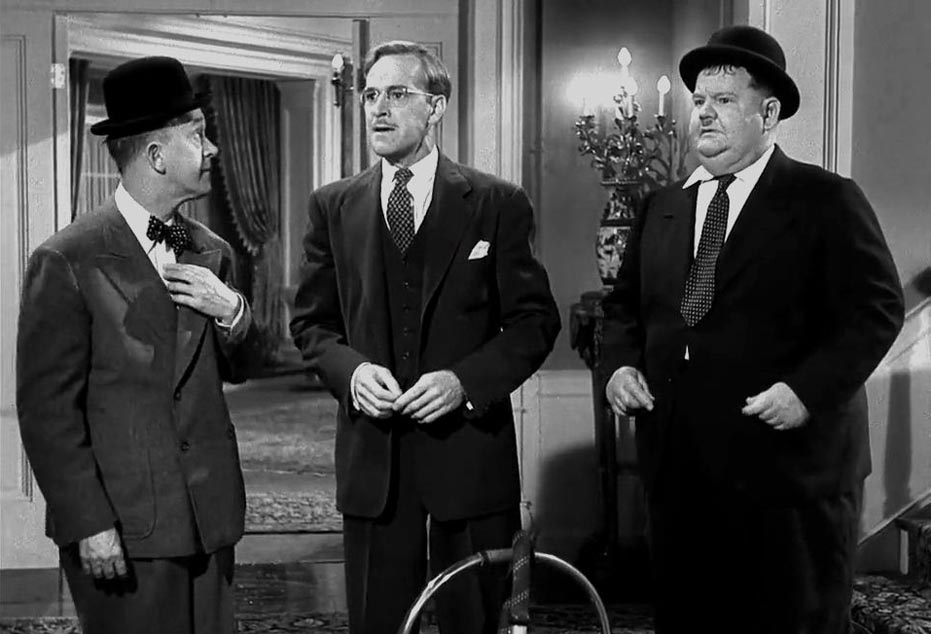
Local Morgan Beach Celebrity Arthur Space portraying the character Alva P. Hartley in a movie still from the 1944 Laurel & Hardy movie, “The Big Noise”.
Morgan Beach Goes Hollywood
My mom told me about one of the young people in her day at Morgan Beach who later became an actor. Finally, I looked him up on Google/Wikipedia/IMDB. Arthur Space was born Charles Arthur Space in New Brunswick on October 12, 1908. He spent some of his early life schluffing on Morgan Beach and going to perform in plays at New Jersey College for Women which was part of Rutgers University in New Brunswick. The school was later named after its founder Mabel Smith Douglass in 1955 to Douglass College then after 2007 became Douglass Residential College.
Arthur Space never achieved huge Hollywood fame but appeared in many movies and television programs between 1942 and 1981. IMDB identifies 283 titles that he was in. In movies, he acted alongside such prominent stars as Spencer Tracey, Van Johnson, Hedy Lamarr, Laurel and Hardy, Abbot and Costello, Edward G. Robinson, Red Skelton, Randolph Scott, and many others. He also made appearances in many well-known TV programs with probably his most notable television role portraying Dr. Frank Weaver in 41 episodes of Lassie.
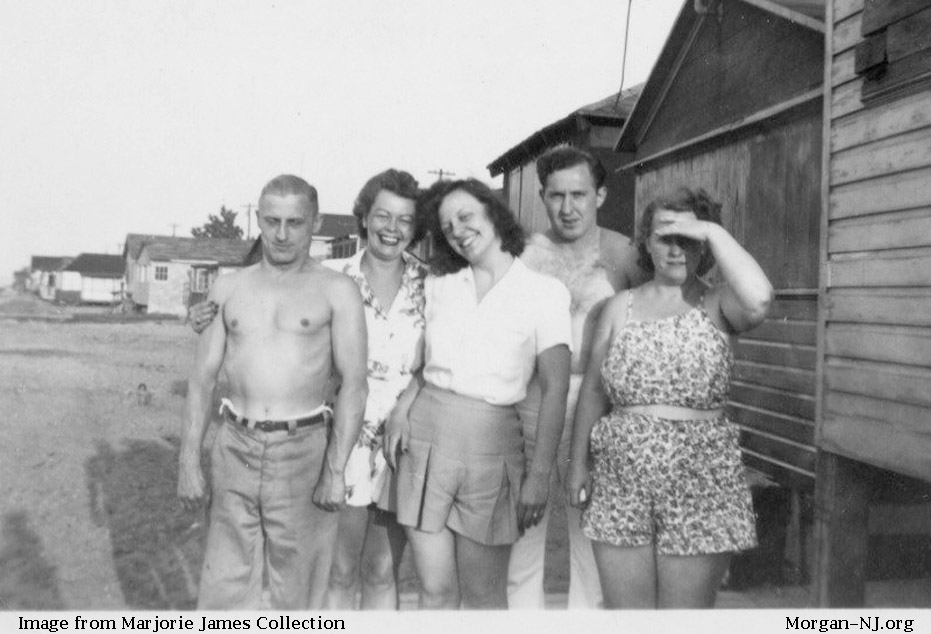
Edward Thalmann, Anita Thalmann, Marjorie James, Verne James, and Josephine Thalmann on Morgan Beach Circa 1946. Image courtesy of Marjorie James.
An Unlikely Encounter
At one point in my professional career working for a vendor of Automated Fingerprint Identification Systems, I had the opportunity to visit the Los Angeles, California US Secret Service office. While speaking to one of the agents, the topic of being from New Jersey somehow came up at which time he fondly mentioned that as a kid, he spent at least one joyful summer at a little beach on Raritan Bay. Would you believe that beach was Morgan Beach!
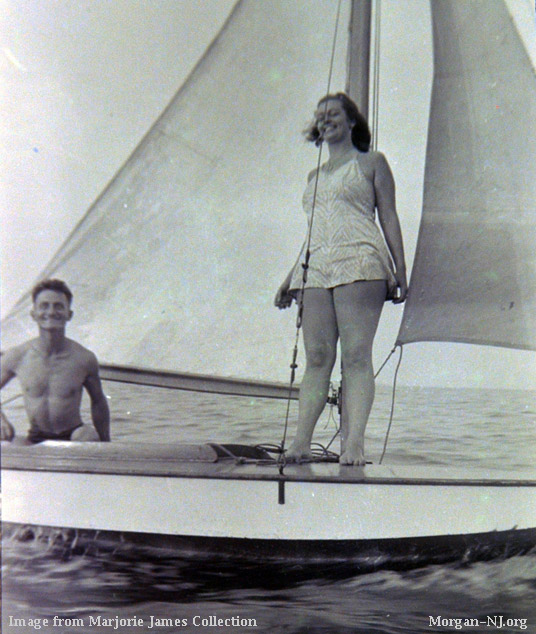
Edward Thalmann and Anita Thalmann sailing off the Morgan Beach Coast. Image courtesy of Marjorie James.
More Citizen Blurbs
Here is a whole page containing references to Morgan Beach in the South Amboy Citizen from between 1911 and 1926. Imagine a crowd of 2,500+ people on the sands of Morgan Beach on August 10, 1913, or an even larger one on July 9, 1921!
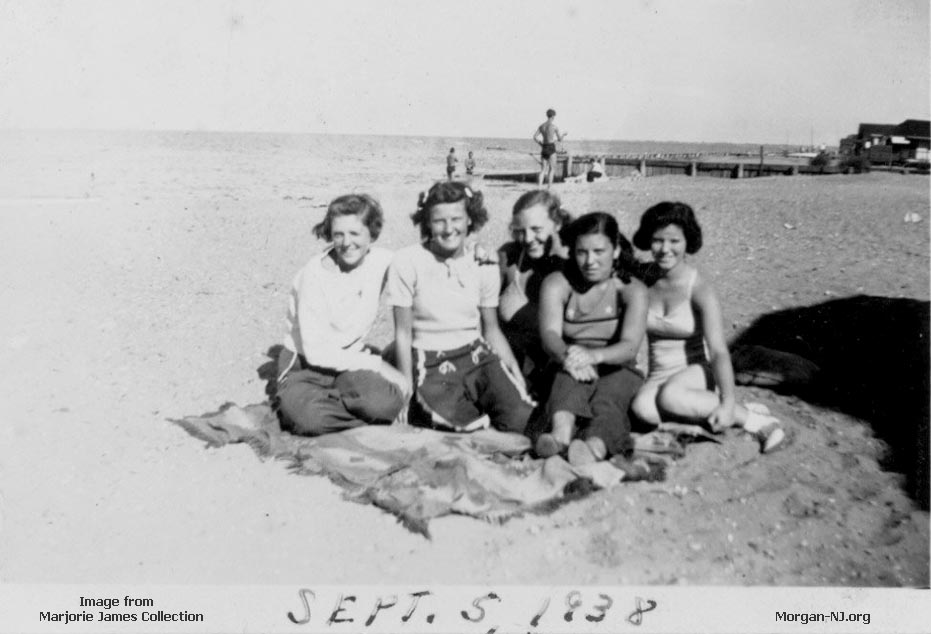
Rita Casey, Dorothy Thalmann, Marjorie Thalmann, Unknown, and Dot Mocolinio on Morgan Beach on September 5, 1938. Image courtesy of Marjorie James.
Charles Steuerwald
I still don’t yet have definitive information on when Charles Steuerwald acquired Morgan Beach. Steuerwald was a local land developer and the driving force behind Wesco Reality which developed the area of Morgan on the bay side of South Pine Avenue between Christ Church Cemetery and Luke Street. This property, which includes Jesse Selover School, had previously been “Sandcombe,” the estate of Robert Stevens Conover (no, NOT the estate of the Morgan Family).
In the early 1900’s there was the possibility of a Ship Canal cutting across New Jersey from Bordentown on the Delaware River to the channel at Morgan Beach. Owning the beach at the eastern terminus of the ship canal might have proved to be a very lucrative investment. This might have been the catalyst which caused Steuerwald to acquire the property, and if so, probably from Archibald Rowan (perhaps someday someone will be able to check the property records).
Well, the ship canal never happened.
My mom recalled the rental checks for the land under the family bungalow went to Mrs. Steuerwald. Charles had passed away at some earlier point.
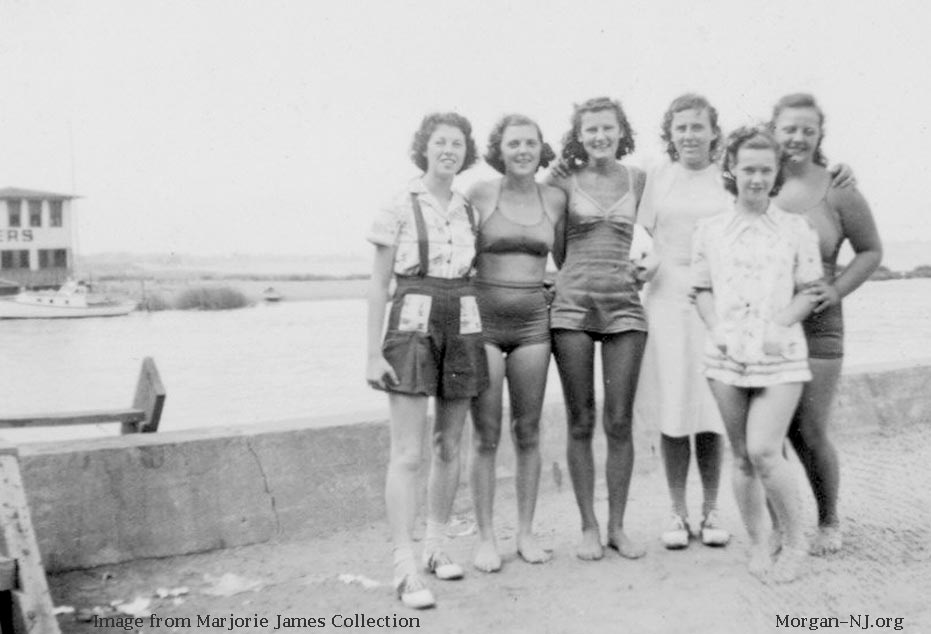
Florence Muth, Rita Casey, Dorothy Thalmann, Doris Kaiser, Bette Adams, and Marjorie Thalmann Overlooking Cheesequake Creek Channel on Morgan Beach circa 1938. Across the Channel is the Robert E Lee Inn. Later, Doris Kaiser and her husband Jules owned and operated Kaiser’s on the beach. Image courtesy of Marjorie James.
Kaisers
Located overlooking the channel where the road met the bridge, Kaiser’s was the place to be at Morgan Beach though the structure was there well before it was Kaisers. An image of its previous incarnation as Willett’s Pavilion can be seen by clicking here. By April 1956, Julius Petryk and Doris Kaiser Petryk were in the process of moving the business off the beach to another location. In April 1956, they applied for the “Liquor License” to the Sea-Shell Bar & Grill.
South Amboy Citizen – April 12, 1956
Notice is hereby given that application has been made to the Borough Council of the Borough of Sayreville, New Jersey, for the transfer of a Plenary Retail Consumption License for premises situated at Route 35 and Tyler Street, Sayreville (Morgan), Middlesex County, N. J., formerly issued to George S. Vanderhoof and Marion Vanderhoof, trading as Sea-Shell Bar & Grill, at Route 35 & Tyler Street, Sayreville (Morgan), Middlesex County, N. J.
Objections, if any, should be made immediately in writing to Mary C. Guilfoyle, Deputy Clerk of the Borough of Sayreville. N. J.
Julius Petryk
Doris Kaiser Petryk
18 Morgan Beach,
Morgan, Madison
Township. N. J.
The new location was just a little further north on Route 35 at the intersection of Route 35 and Tyler Street – right across Route 35 from Joe’s Kozy Bar and the future Club Bene. Later, the June 1958 license application shows the new location at Highway 35 & Tyler St. to be sporting the Kaiser Bar & Grill name. It was here where adults went to hang and kids in the neighborhood went for candy (and baseball cards).
Jules passed away in the 1970s, sometime after which Doris sold the business and moved away. Doris passed away around 1983. The building at Route 35 and Tyler was modified and become Covello’s Italian Seafood Restaurant.
A few years ago as of the time of this writing, after the death of Mr. Covello, the restaurant closed and the building sold. Under the new owners, the building was partially demolished and, to the horror of local residents, sat in that state for quite some time. As of the time of this writing in late 2018, construction hasn’t fully completed!
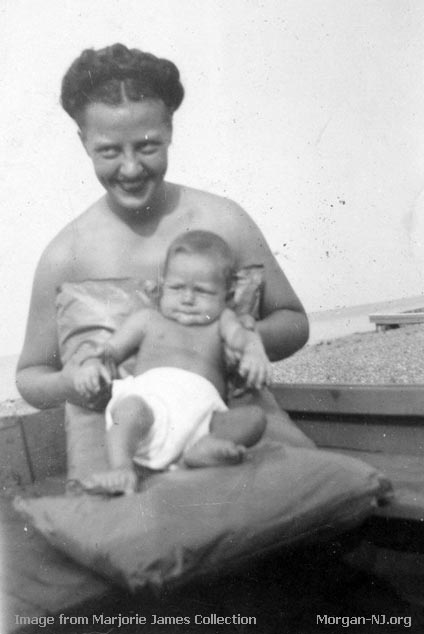
Marjorie Thalmann holding baby Edward Thalmann on Morgan Beach circa 1946. Image courtesy of Marjorie James.
Cousin Edward spent a lot of time at Morgan Beach as a young child starting from the time he was born. He developed a lifelong passion for trains from the steam trains which would pass by on the nearby railroad. Relatives said that Edward would always react to the passing train and find a way to watch it go by. During his life, he acquired a wondrous collection of model trains, many beautifully hand built by him, and would travel by train as often as possible.
Other than his children, Ed’s greatest accomplishment was his medical research in the field of diving for the US Navy while a medical doctor and senior officer. He was a, perhaps “the” foremost authority in his field of “hyperbaric medicine” and developed the “Thalmann Algorithm” used by divers (and incorporated into diving watches) to ward off the dreaded decompression sickness otherwise known as “The Bends.” The Roeblings would have benefited greatly from Edward’s research if it had been available 100 years before during the time the Brooklyn Bridge was being constructed.
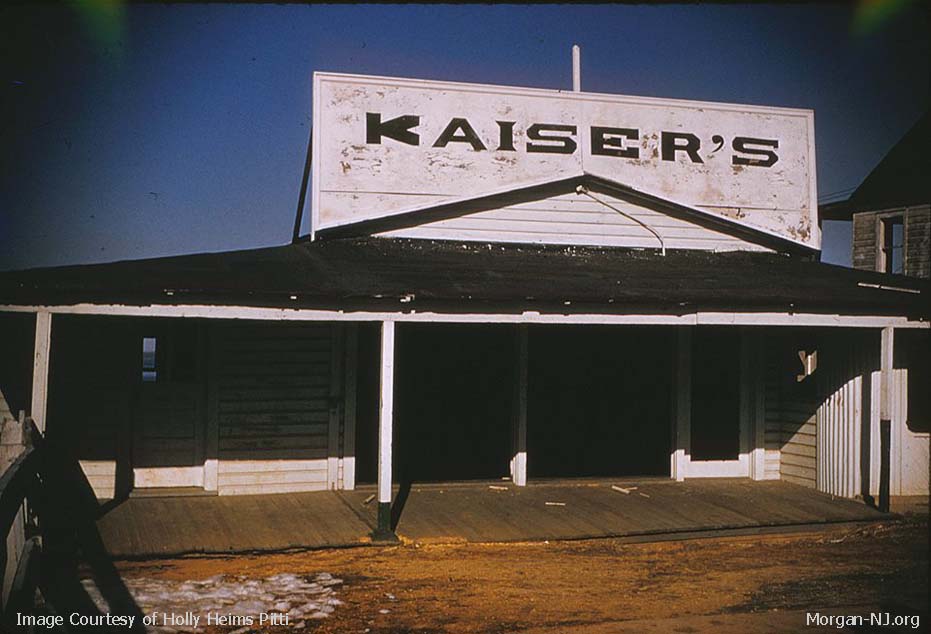
Kaiser’s Tavern on the Banks of Cheesequake Creek on Morgan Beach. Image courtesy of Holly Heims Pitti.
Why was Morgan Beach Significant for my Family?
My mom would tell about Morgan Beach days and my dad, if he ever broached the topic of his experience in World War II (which he didn’t really just like most of the rest of his Greatest Generation), mentioned that he patrolled New York Harbor and would on occasion bring his boat to the boatyard of Henry Luhrs on Morgan Creek for repairs/maintenance. He and the other boat crew members would then cross over the then-new Morgan Bridge and end up at Kaisers Pavilion. The beach wasn’t all that big and Kaiser’s Pavilion was the place to go for the people staying on the beach. Guess who met there!
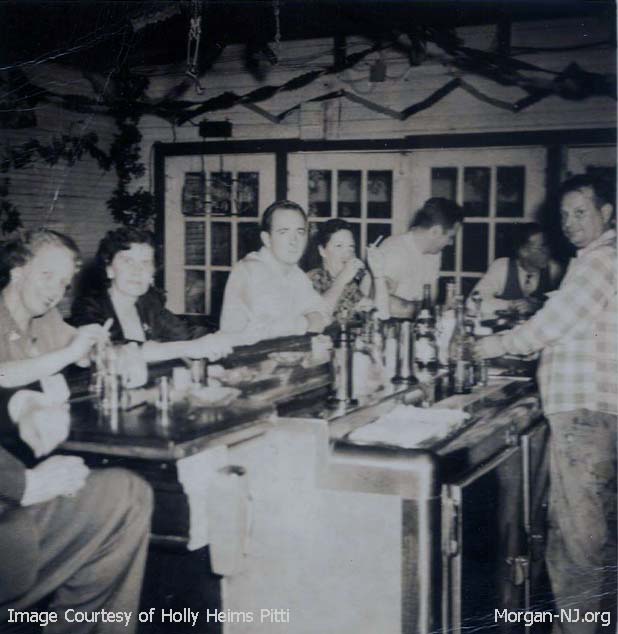
Inside Kaiser’s Tavern at Halloween
Inside of Kaiser’s Tavern at Morgan Beach on Halloween sometime in the mid-1950s. Behind the bar on the right is Julius “Jules” Petryk (husband of Doris Kaiser Petryk). Image courtesy of Holly Heims Pitti.
After the war ended, it took my dad three months to get back home to Missouri from the Philippines. Shortly after that, he traveled back to New Jersey and married her! They remained very happily married until he passed away too early in 1987.
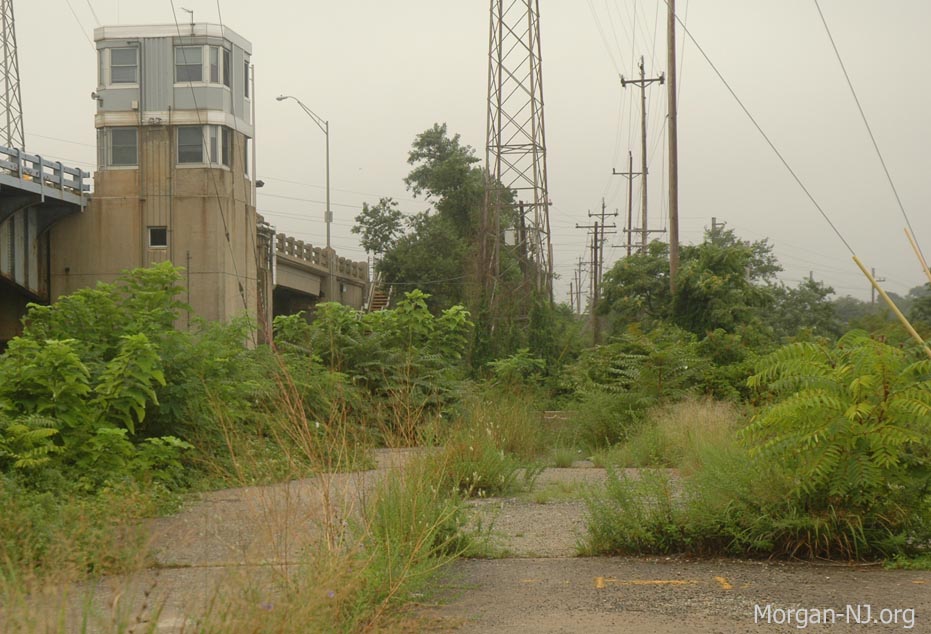
Remains of Old Route 35 at Morgan Beach as of August 2011. The current tower of the current Route 35 Morgan Bridge is on the left.
Brother Doug’s Memories
While also too young to remember the bungalow at Morgan Beach, my brother Doug did have some Morgan Beach memories to share:
At ‘High Tide’ the slope of the beach at the high tide mark made it possible to have your boat anchored maybe as close as 10 feet off the beach and there were LOTS of ’em. It was awesome. Boats of all sizes, both sail and motor, maybe 20-40 of them, maybe more, lined up all the way to Laurence Harbor. AND, you could actually swim in water 6 to 8 ft deep for about 4-5 hours before it got knee deep again at low tide as far out as the ‘Lolly Pop’.
The beach itself was all pebbles, BIG pebbles, some maybe two inches in diameter. They were everywhere on the beach from the parking spots, where the bungalows stood, to the water and they hurt my feet. Almost everyone who came down back then used their old driveways, parked where their missing bungalow used to stand and set up their little patch of beach where they had been since before Christ. THEN in the mid-60’s, someone decided to pump sand onto the beach so it didn’t wash away in the next storm and there went the FUN times on Morgan Beach. The people who owned the bungalows (not the land)stopped going there basically because the water was never that swimmable again and still isn’t.
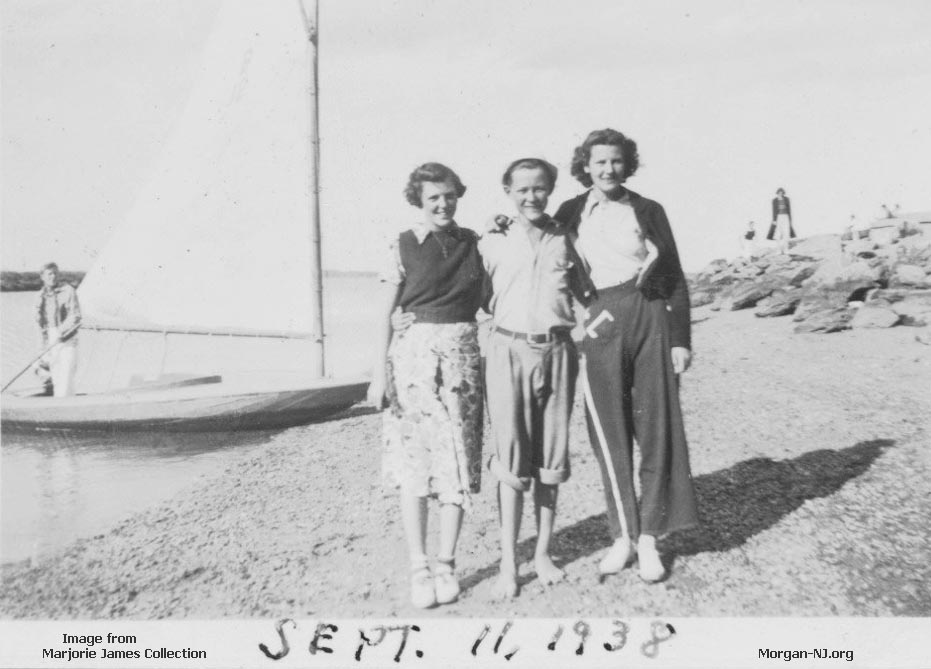
Beachcombers Eddie Kaistner (on sailboat “B-12”), Rita Casey, Billy Vroome, and Dorothy Thalmann on the channel on September 11, 1938. Image courtesy of Marjorie James.
The End?
Regarding the demise of the bungalows at Morgan Beach, what my mother told me goes as follows (and differs from Don Hannon’s reflections): Mrs. Steuerwald sold the beach to an oil company which wanted to put up storage tanks in the same fashion as had been done on the Raritan River at Perth Amboy. Being that the people who lived year-round or seasonally on Morgan Beach owned the structures but leased the land, everyone had to get off the beach. Also per Mom, the Governor of New Jersey didn’t allow for the oil storage tanks to be built on the Morgan Beach so ultimately it was all for naught.
Other people credit the final demise of the beach to be due to hurricanes or one specific one, though which one is unclear.
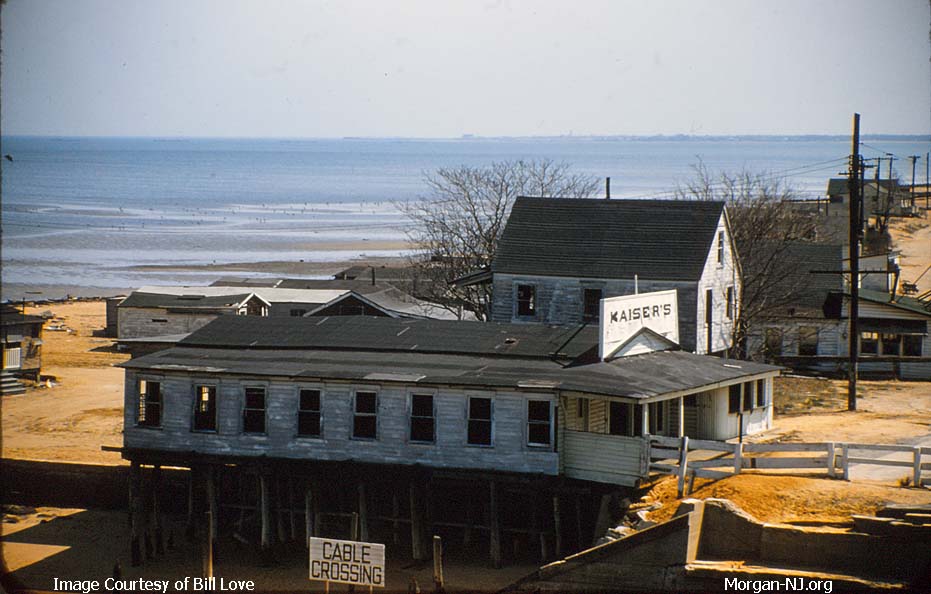
Remains of Kaisers at the end of Morgan Beach Days circa mid to late 1950s. Image courtesy of Bill Love.
After years of searching, I finally found an article from the July 14, 1955, Matawan Journal which answered many of the questions:
Land Sold Out From Under Their Homes
Morgan Beach Owners Must Move Quickly
Sixty Morgan Beach residents who have had the land sold from underneath their homes held a protest meeting Friday against the serving of 30-day eviction notices on them by the purchaser, Reliance Associates, of Iselin. They have been living on land leased from the Morgan Beach Co.., some of them for as long as 45 years. They have been told to move their houses from the land or have them demolished when the buyer gets ready to develop the property.
Edward J. Patten, Perth Amboy, acting as attorney for the residents, informed them the Morgan Beach Co., headed by Mrs. Charles Steuerwald, Perth Amboy, had sold the property June 16 and the deed was recorded June 22. Mr. Patten averred he would have a search made of the properly to see if any flaws to title could be uncovered which would at least tie the buyers’ hands for a period of dealing with the homeowners.
The homeowners at the meeting demanded angrily to know why the deal transferring the land from under their homes had been consummated with such secrecy. They claimed it was “unfair” they were given no notice of the intent of the owner to sell the land so they would have more than 30 days to seek new sites. Mr. Patten advised them that it was customary in real estate practice to keep deals as secret as possible until they were consummated by transfer of deed.
Most of the residents claimed they had not received eviction notices personally but that only a few were issued, principally to the business establishments, such as Kaiser’s and Ruane’s Delicatessen. Mr. Patten said he did not think notices to each and every resident were necessary, that they had merely served to let the sale be known. Ray Heaber, reported he had received a call from a man named Thomas Riley who said he had read in the papers about the plight of the colony and offered to sell them land he owns in Oceanport.
Some residents own businesses and will lose their livelihood if they have to move. Many of the residents were forced to rebuild their beach homes after the hurricane of November 1950 destroyed or heavily damaged them.
As one woman remarked at the meeting, many of the residents haven’t the money to move their bungalows to a new site or to buy or rent elsewhere. Typical of the houses is that of Mrs. Kathryn Ruane, a widow who operates a small grocery and luncheonette, who values her building at $3500.
One resident declared, “Most of us here haven’t got the price of a doghouse, much less the price to move.”
On the other hand, Mr. Patten pointed out, if an extension is not granted on the evictions, those falling to move their homes and possessions within the staled time could by law lose their personal belongings. This, he said, especially applies to businesses where the business fixtures and stock may be confiscated.
Friday’s session was held in the open in front of Kaiser’s Pavilion. The new owner allegedly refused to allow the meeting to be held in the building for fear it might prove unsafe for a large crowd.
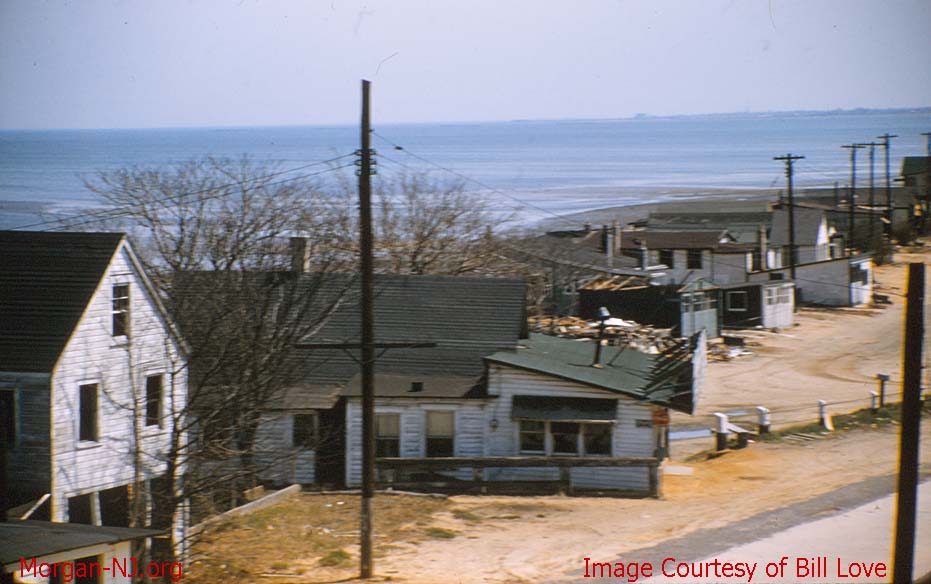
Remains of Ruanes at the end of Morgan Beach Days circa mid to late 1950s. Image courtesy of Bill Love.
Nearly two years later, an article from the March 7, 1957, Matawan Journal indicates that half of the families were still living on the beach.
Thirty Families To Face Eviction
Morgan Beach Area Residents Effected
Approximately 30 families in the Morgan Beach section of Madison Township face eviction from the houses in which they are living after May 1, according to a recent ruling handed down by District Court Judge George R. Morrison. In his ruling, Judge Morrison denied writs of eviction which would have forced the families to move from their houses during the winter season.
The owners of the property Reliance Associates of New York, brought court action against the homeowners last fall in an effort to gain possession of the land in order to build a new development. At the time, Judge Morrison informed the owners of the land that it would not be proper to evict them at the approach of the winter season and the eviction notices were put off. Since that ruling, the plaintiffs asserted, they have not been able to collect rents.
Must Pay Rent
Judge Morrison, in his latest ruling, set the May 1 dead line with a proviso that the 30 families pay rent in the mean time. Reliance Associates stated they have not been able to collect any rents since Nov. 1, 1956. Many of the families concerned were present in the courtroom with children when Judge Morrison issued his ruling in District Court.
William Holden, acting as temporary spokesman for the residents until a planned organization is set up, claimed that most of the owners have not paid rent of late because they did not know where to pay it. They claimed that ownership of the land changed hands without any notification of the transaction being given to the owners of the homes.
According to one of the interested parties, the rent for the shore space occupied by their bungalows is about $97 a year, plus approximately $25 water rent.
It is claimed the ruling not only represents the necessity of securing enough money to pay the back rent, but the homes are a bigger problem.
When did everyone finally clear off? I don’t have that answer yet.
If you have any other stories or information about Morgan Beach, including the demise of the Morgan Beach colony, please let us know below. Perhaps we’ll be able to incorporate your story in a future update to this page!
Originally posted on September 22, 2018.
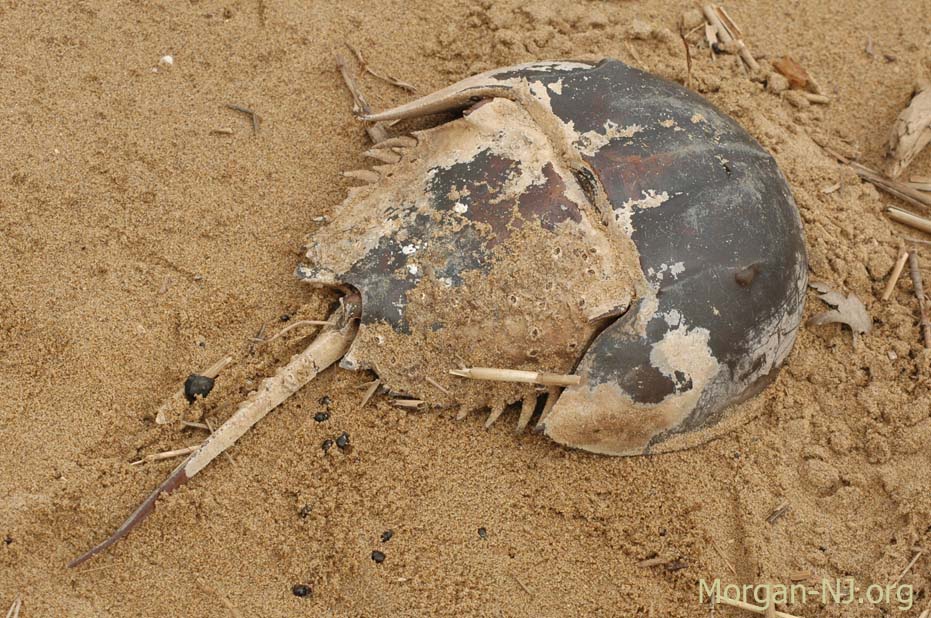
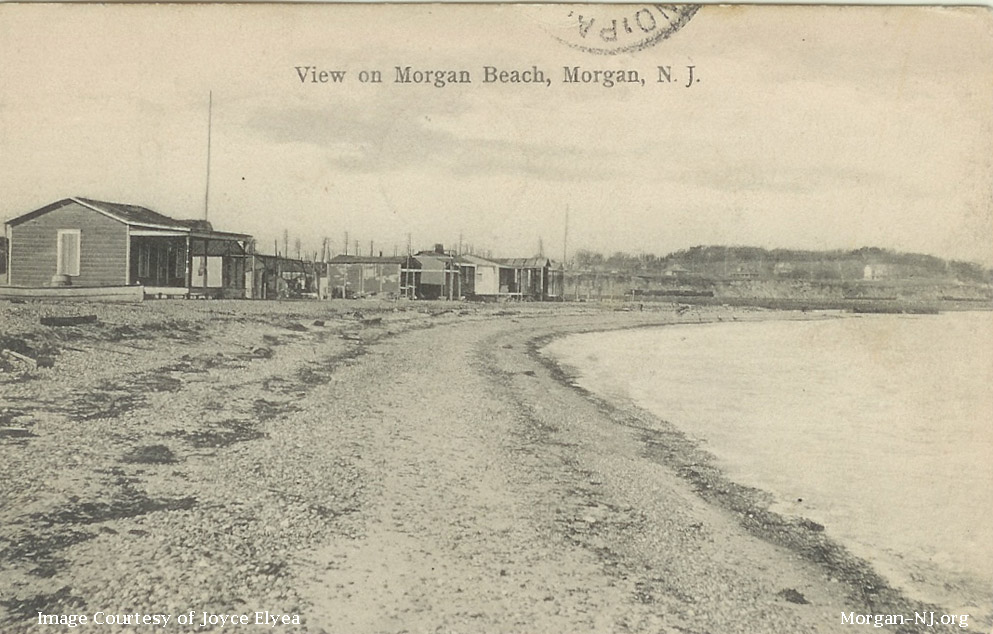
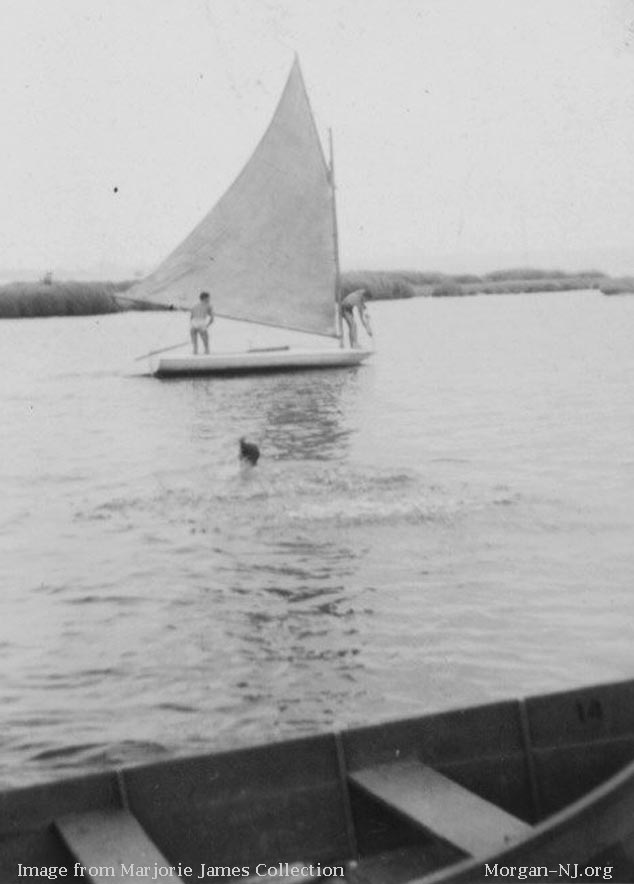
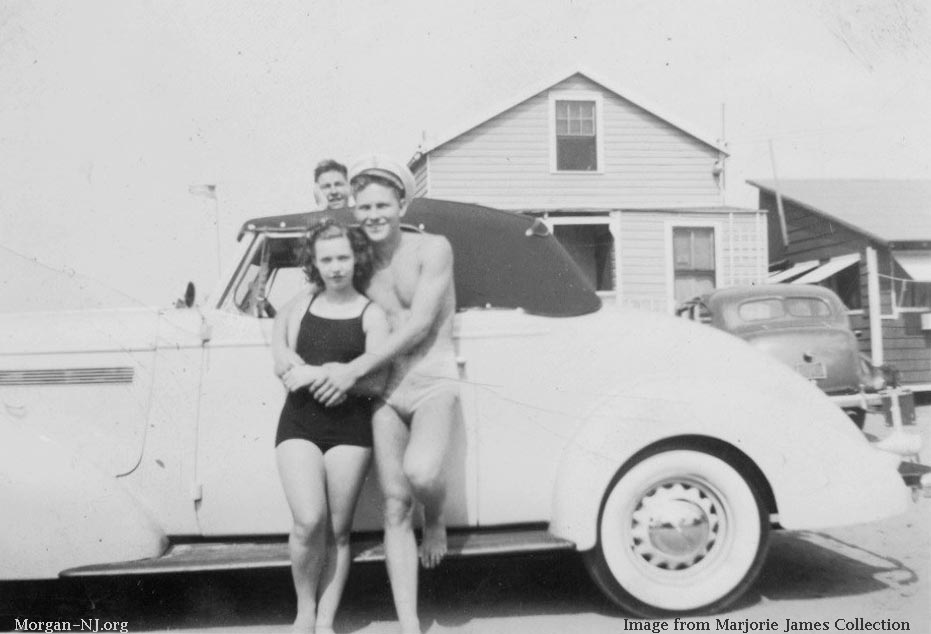
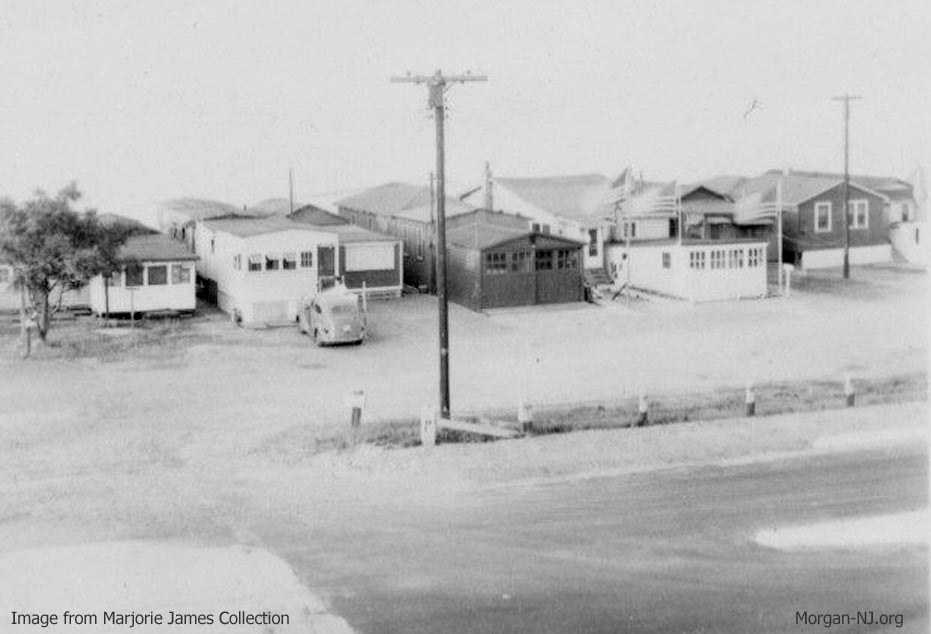
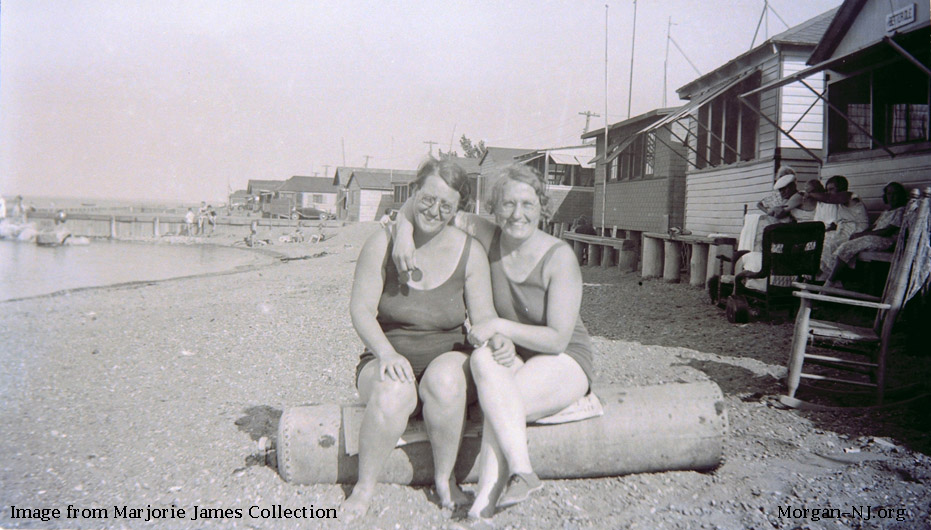
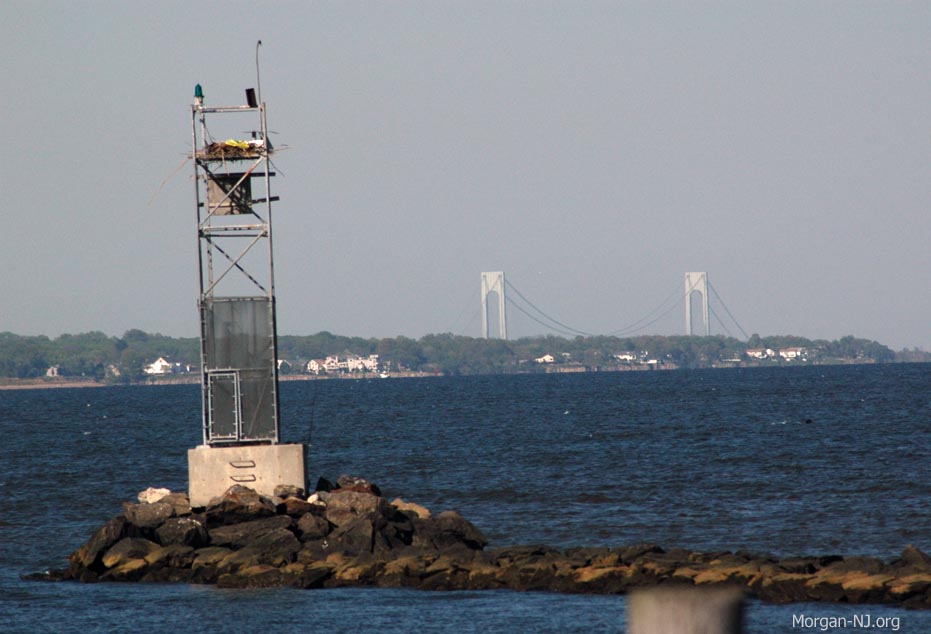
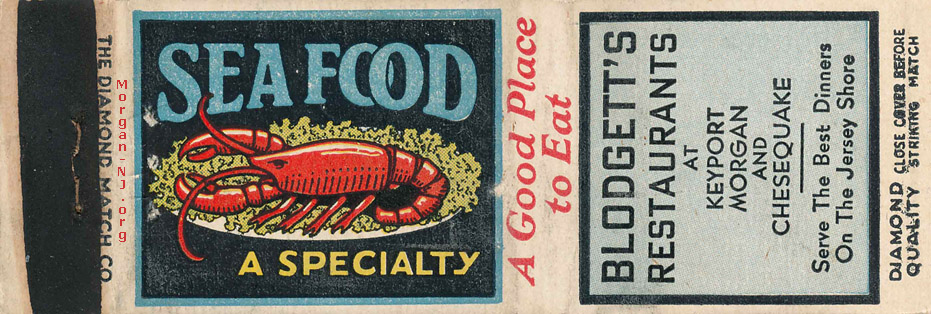
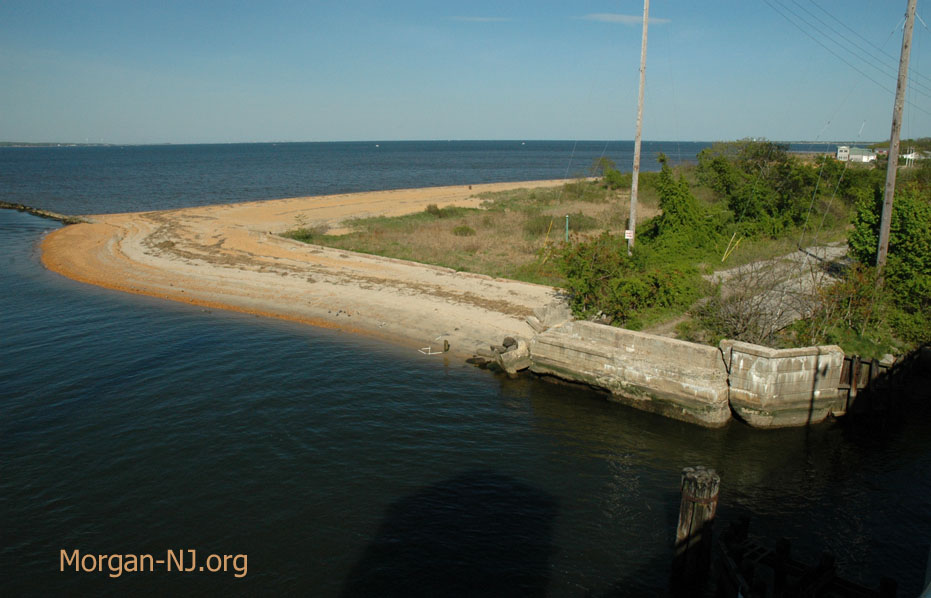
This was such a find for me. Morgan Beach. My aunt owned 2 bungalows, she rented one out and many of the family stayed in the other. The were 3 rooms that I remember – a huge kitchen (fly paper over the kitchen table), a bedroom and a so-called living room. It was always full of family, I don’t remember where they all slept. My mother and I rented a little bungalow a few houses down the road every summer. Uncles and Fathers came down on weekends. Showers were outside or else you took a bath in a galvinized tub in the kitchen. I remember coming and going at Ruanne’s store, the only store around. I think they had a pin ball machine and also at Kaiser’s. Truth be told I think the “girls” spent a whole lot of time at Kaiser’s and the kids did also. Even as very young kids we had free reign – out all day doing who knew what. The only rule I remember is not to try to swim across the channel.
I certainly feel out of place reading this. I am a 17 yr old living in Morgan Beach, now commonly referred to as Laurence Harbor, a nod to the St. Laurence Church down the road. I am doing a documentary on the of the little Bowne-Provost Family Cemetery, and was recommended this page by my Film teacher. I am currently living on top of what i assume was the golf resort spoken about in the article. Only a couple of blocks away from aforementioned cemetery, if that gives any sort of indication.
My family moved here when i was entering middle school, only seven years ago, so i cannot say anyone in my immediate family has been here long. Reading your story has made me nostalgic for a past i have never been a part of. If you are in the area, i would love to interview you for my school project. it would mean alot if those in my class had heard anything you had to offer about the good old days of Morgan Beach.
Feel free to contact me at acool469@obps.org
Interesting read about Morgan. I grew up there from 1947 until 1959. My father and mother ( Lenny and Ruby Bauer) built a house at 193 Morgan Ave overlooking the Bay. I spent every summer at the Morgan beach crabbing and swimming in the canal. We learned how to swim in the canal which had a pretty swift current. We went from the beach side to the Robert E Lee dock. At the time Kaiser’s was still open and there were a number of bungalows on the beach. The Hurricanes of 1955 ( Connie and Diane) washed a number of houses into the bay. This was the beginning of the end. Robert E Lee stayed open for a time after that but it gradually declined. My family was involved with the Boy Scouts and cub scouts in Morgan and my mom worked at Gene’s roadside stand on Route 35 by the train bridge. I went to Jesse Selover School and delivered the Newark News to some of the locals when I was around 9 years old. It was a great place to grow up, lots of freedom.
Some of my childhood friends were Bobby Johnson, Gary Brown, Tom Newsome, Lenny -not sure of last name.
Hi Bruce! Thanks for your comments. I’ve been looking forever for any images or further info about Gene’s. Did your mother happen to have any photos of it? Thanks! Verne